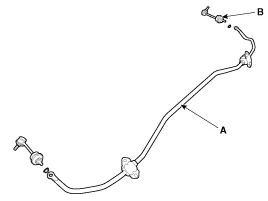Hyundai Genesis (DH): Rear Suspension System / Rear Stabilizer Bar Repair procedures
Hyundai Genesis (DH) 2013-2016 Service Manual / Suspension System / Rear Suspension System / Rear Stabilizer Bar Repair procedures
| Removal |
| 1. |
Loosen the wheel nuts slightly. Raise the vehicle, and make sure it is securely supported. |
| 2. |
Remove the front wheel and tire (A) from the rear hub.
|
| 3. |
Loosen the bolts and remove the cover (A). [TAU]
|
| 4. |
Using a hex wrench, loosen the nut (A) while fixing the end of stabilizer link and then disconnect the link from the lower arm.
|
| 5. |
Loosen the mounting bolt (A) and then remove the stabilizer bar (B).
|
| 6. |
Disconnect the rear stabilizer link (B) with the stabilizer bar (A).
|
| 7. |
Installation in the reverse order of removal. |
| Inspection |
| 1. |
Check the bushing for wear and deterioration. |
| 2. |
Check all the bolts. |
| 3. |
Check the stabilizer bar for deformation. |
Removal 1. Loosen the wheel nuts slightly. Raise the vehicle, and make sure it is securely supported. 2. Remove the front wheel and tire (A) from the rear hub.
Other information:
Hyundai Genesis (DH) 2013-2016 Service Manual: Compressor Description and Operation
Description The compressor is the power unit of the A/C system. It is located on the side of engine block and driven by a V-belt of the engine. The compressor changes low-pressure and low-temperature refrigerant gas into high-pressure and high-temperature refrigerant gas.
Hyundai Genesis (DH) 2013-2016 Service Manual: Console Temperature Control Actuator Repair procedures
Inspection 1. Turn the ignition switch OFF. 2. Disconnect the console temperature control actuator connector. 3. Verify that the console temperature control actuator operates to the defrost mode when connecting 12V to terminal 3 and grounding terminal 4.
Categories
- Manuals Home
- Hyundai Genesis Owners Manual
- Hyundai Genesis Service Manual
- Heating, Ventilation and Air Conditioning
- Engine Electrical System
- Starter Repair procedures
- New on site
- Most important about car
Copyright В© 2025 www.hgenesisdh.com - 0.0334






